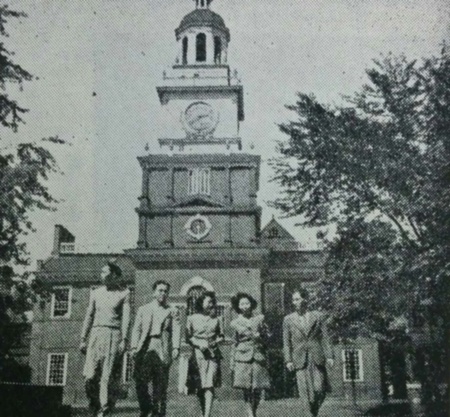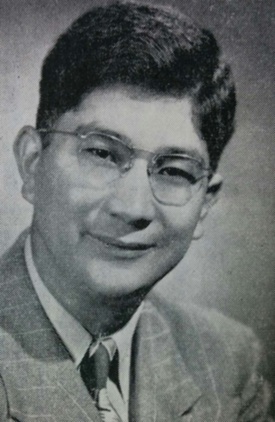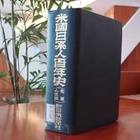In the 23rd chapter of "Centennial History," the book summarizes the Japanese communities in the "Mid-Atlantic States," including the District of Columbia, Maryland, Delaware, Virginia, and Western Virginia. However, the focus of the book is on Japanese and Japanese-Americans in the capital, Washington, DC. There is almost no mention of Japanese-Americans in other states.
The District of Columbia is Washington DC, also written as Washington-fu and in Chinese characters as Hua-fu.
As far back as May 1860, Niimi Buzennokami Masaoki and his party visited Huafu as part of a mission to the United States to sign the Treaty of Amity and Commerce between the United States and Japan, and in 1870 Mori Arinori was appointed as the first Japanese envoy to the United States.
After that, Japanese people began to come to Huafu as settlers or workers around the time of World War I in 1914 and 1915, including merchants from New York and Japanese sailors from the Atlantic coast.
The subsequent events are recorded briefly, but are accompanied by some memorable anecdotes.
"In 1926, the National Typewriter Convention was held in Huaynais, and about four second-generation Japanese-Americans were selected from the region to compete. Among them, Miss Mary Hirakawa was the first Japanese-American to find employment in the Huaynais federal government. After that, around 1940, a dozen second-generation Japanese-American female office workers were working in various offices in Huaynais."
In addition, the book introduces some specific individuals who were active in Japan. Tasaka Sekio, who came to Huafu in 1912, was from Osaka and transferred to the United States after a tour of South America. He opened a flower garden and an art shop in Huafu and became successful.
Gen'ichiro Nishio was born in Kanazawa City, Ishikawa Prefecture, and graduated from a photography college in Tennessee in 1912. He worked as a retoucher at a photo shop in Kanazawa, and is said to have even retouched photographs of the president.
Originally from Okinawa, Satoru Shimasho moved to Hawaii at the age of 14 in 1914. He worked hard to earn his way through the University of Hawaii and then studied law at Georgetown University in Hawaii. He also studied at a flight school and ran his own flight school. After the war, he opened a Japanese restaurant, making him one of the pioneers of Japanese people in Hawaii.
Known as an international critic, Kawakami Kiyoshi was active in Seattle, then studied at Iowa State University, before entering China around 1916 and beginning his life as a writer.
"The creator of the Nisei Corps"
Among these introductions, one person is given special treatment: "Mike Masaoka." This chapter is almost entirely devoted to introducing this person. The Centennial History devotes three pages to Mr. Masaoka, who is generally known in the field of immigration history as Mike Masaoka.
He details his experiences as a "forefront hero of his race," the founder of the Nisei Corps, and a man of many legislative achievements related to the rights of Japanese Americans.
The book begins by covering his upbringing, including his birth in Fresno, California to a father from Kumamoto Prefecture, his achievements during his high school and college years, his election as the first paid secretary-general of the Japanese American National Citizens Union in 1941, and his work for the first generation of Japanese Americans during the chaotic period after the outbreak of war.
As "the father of the second generation unit," he wrote:
"During that delicate period when first and second generation Japanese Americans were running wild with emotion and anti-Japanese sentiment was strong among Americans, Mr. Masaoka advocated the establishment of second generation units, believing that the loyalty of Japanese citizens was an urgent matter, cooperated in the formation of Regimental Unit 442, prevented the permanent continuation of the relocation centers established in the South, East, and Midwest, and demanded that the US authorities open the western coast to Japanese Americans as soon as possible."
He also served on the European front as a member of the 442nd Regimental Combat Team and made a distinguished contribution. As a lobbyist, he is said to have been instrumental in getting many bills passed.
Examples of these bills include the Immigration and Naturalization Act (Walter McCarran Act, 1952), the Refugee Relief Act (1953), the Military Bride Act (1947), and the Eviction Compensation Act (1948).
Centered in Philadelphia
Regarding Japanese people in Pennsylvania, the book summarizes their footsteps in Philadelphia, the state capital and birthplace of the American independence movement. The Centennial History refers to the city as a "Fushishi."
"The census shows that as far back as 1880, eight Japanese were living in Peru. As the statistics on the left (census) show, in 1940, before the war, there were only 224 Japanese people in Peru. In 1950, this number jumped to 1,029, and ten years later, in 1960, this number more than doubled to 2,348. This is due in part to second-generation immigrants who found work in factories and offices, and students from Japan, but as in other states, this is also due to a rapid increase in military brides."
As in Boston, Japanese people arrived in Philadelphia in the 1890s and are believed to have settled there as tea merchants, general merchandise merchants, students, and domestic workers.
As an example, he mentions a man named Tatsutake Baba. His grave still remains in the city today (around 1960). He is said to have come to the city to study around 1894 or 1895, and after working hard to earn a good education, he returned to his hometown for a while, working as a waiter in a hotel or other establishment.
It is said that when President Grant visited Japan, he specifically requested that Baba Tatsutake be called, saying, "Baba Tatsutake should be in Japan.
Also, Senoo Morizo (from Okayama Prefecture) came to the United States in 1897 and lived in Atlantic City (New Jersey) for a dozen years before moving to Philadelphia in 1912. He opened a Japanese art store and also worked in the business of loading food onto Japanese ships.
"Before the war between Japan and the United States, during the Second Sino-Japanese War, the Japanese military bombed the US military hospital ship Panay when it landed on the Yangtze River. This led to angry citizens picketing and boycotting Japanese products for three months, which caused great losses."
Supporting second generation Japanese-Americans in transferring to and attending college
When the war between Japan and the United States began, there was an active movement in Philadelphia to accept second-generation Japanese college students living on the Pacific coast who were unable to continue their studies locally.
The first students began to move there around the summer of 1942, and the Student Relocation Committee was instrumental in making this happen.
"The Student Relocation Committee was established by Dr. John Nason, president of Swarthmore College in Washington DC, who felt it was unfortunate that many promising young students were wasting their time because of the war and could not find a new school to transfer to. He approached major universities in the Midwest and east and held a joint meeting with the Relocation Bureau to form the committee. Dr. Nason himself served as chairman, and with the help of this committee, over 2,300 Japanese American students were able to transfer and enroll in universities around the country, even during wartime. When we think about the fact that after the war, the second generation Japanese American graduates from these universities are active in all walks of life across the United States, the work of the Student Relocation Committee, led by Dr. Nason, is immeasurably significant."

(Note: I have used the original text as much as possible, but have made some edits. Titles have been omitted.)
*Next time we will introduce " Japanese Americans in the Southern Atlantic States ."
© 2015 Ryusuke Kawai







